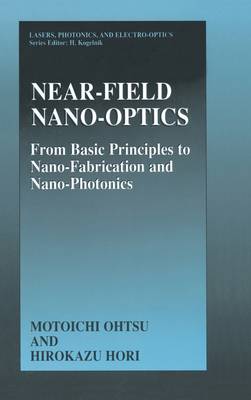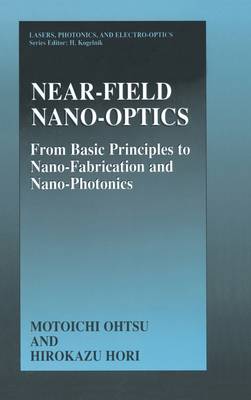
- Afhalen na 1 uur in een winkel met voorraad
- Gratis thuislevering in België vanaf € 30
- Ruim aanbod met 7 miljoen producten
- Afhalen na 1 uur in een winkel met voorraad
- Gratis thuislevering in België vanaf € 30
- Ruim aanbod met 7 miljoen producten
Zoeken
Near-Field Nano-Optics
From Basic Principles to Nano-Fabrication and Nano-Photonics
Motoichi Ohtsu, Hirokazu Hori
€ 151,45
+ 302 punten
Uitvoering
Omschrijving
1. Introduction.- 1.1. Near-Field Optics and Photonics.- 1.1.1. Optical Processes and Electromagnetic Interactions.- 1.2. Ultra-High-Resolution Near-Field Optical Microscopy (NOM).- 1.2.1. From Interference- to Interaction-Type Optical Microscopy.- 1.2.2. Development of Near-Field Optical Microscopy and Related Techniques.- 1.3. General Features of Optical Near-Field Problems.- 1.3.1. Optical Processes and the Scale of Interest.- 1.3.2. Effective Fields and Interacting Subsystems.- 1.3.3. Electromagnetic Interaction in a Dielectric System.- 1.3.4. Optical Near-Field Measurements.- 1.4. Theoretical Treatment of Optical Near-Field Problems.- 1.4.1. Near-Field Optics and Inhomogeneous Waves.- 1.4.2. Field-Theoretic Treatment of Optical Near-Field Problems.- 1.4.3. Explicit Treatment of Field-Matter Interaction.- 1.5. Remarks on Near-Field Optics and Outline of This Book.- 1.5.1. Near-Field Optics and Related Problems.- 1.5.2. Outline of This Book.- 1.6. References.- 2. Principles of Near-Field Optical Microscopy.- 2.1. An Example of Near-Field Optical Microscopy.- 2.2. Construction of the NOM System.- 2.2.1. Building Blocks of the NOM System.- 2.2.2. Environmental Conditions.- 2.2.3. Functions of the Building Blocks.- 2.3. Theoretical Description of Near-Field Optical Microscopy.- 2.3.1. Basic Character of the NOM Process.- 2.3.3. Demonstration of Localization in the Near-Field Interaction.- 2.3.4. Representation of the Spatial Localization of an Electromagnetic Event.- 2.3.5. Model Description of a Local Electromagnetic Interaction.- 2.4. Near-Field Problems and the Tunneling Process.- 2.4.1. Bardeen's Description of Tunneling Current in STM.- 2.4.2. Comparison of the Theoretical Aspects of NOM and STM.- 2.5. References.- 3. Instrumentation.- 3.1. Basic Systems of a Near-Field Optical Microscope.- 3.1.1. Modes of Operation.- 3.1.2. Position Control of the Probe.- 3.1.3. Mechanical Components.- 3.1.4. Noise Sources Internal to the NOM.- 3.1.5. Operation under Special Circumstances.- 3.2. Light Sources.- 3.2.1. Basic Properties of Lasers.- 3.2.2. Characteristics of CW Lasers.- 3.2.3. Additional Noise Properties of CW Lasers.- 3.2.4. Short-Pulse Generation.- 3.2.5. Nonlinear Optical Wavelength Conversion.- 3.3. Light Detection and Signal Amplification.- 3.3.1. Detector.- 3.3.2. Signal Detection and Amplification.- 3.4. References.- 4. Fabrication of Probes.- 4.1. Sharpening of Fibers by Chemical Etching.- 4.1.1. A Basic Sharpened Fiber.- 4.1.2. A Sharpened Fiber with Reduced-Diameter Cladding.- 4.1.3. A Pencil-Shaped Fiber.- 4.1.4. A Flattened-Top Fiber.- 4.1.5. A Double-Tapered Fiber.- 4.2. Metal Coating and Fabrication of a Protruded Probe.- 4.2.1. Removal of Metallic Film by Selective Resin Coating.- 4.2.2. Removal of Metallic Film by Nanometric Photolithography.- 4.3. Other Novel Probes.- 4.3.1. Functional Probes.- 4.3.2. Optically Trapped Probes.- 4.4. References.- 5. Imaging Experiments.- 5.1. Basic Features of the Localized Evanescent Field.- 5.1.1. Size-Dependent Decay Length of the Field Intensity.- 5.1.2. Manifestation of the Short-Range Electromagnetic Interaction.- 5.1.3. High Discrimination Sensitivity of the Evanescent Field Intensity Normal to the Surface.- 5.2. Imaging Biological Samples.- 5.2.1. Imaging by the C-Mode.- 5.2.2. Imaging by the I-Mode.- 5.3. Spatial Power Spectral Analysis of the NOM Image.- 5.4. References.- 6. Diagnostics and Spectroscopy of Photonic Devices and Materials.- 6.1. Diagnosing a Dielectric Optical Waveguide.- 6.2. Spatially Resolved Spectroscopy of Lateral p-n Junctions in Silicon-Doped Gallium Arsenide.- 6.2.1. Photoluminescence and Electroluminescence Spectroscopy.- 6.2.2. Photocurrent Measurement by Multiwavelength NOM.- 6.3. Photoluminescence Spectroscopy of a Semiconductor Quantum Dot.- 6.4. Imaging of Other Materials.- 6.4.1. Fluorescence Detection from Dye Molecules.- 6.4.2. Spectroscopy of Solid-State Materials.- 6.5. References.- 7. Fabrication and Manipulation.- 7.1. Fabrica...
Specificaties
Betrokkenen
- Auteur(s):
- Uitgeverij:
Inhoud
- Aantal bladzijden:
- 404
- Taal:
- Engels
- Reeks:
Eigenschappen
- Productcode (EAN):
- 9780306458972
- Verschijningsdatum:
- 30/06/1999
- Uitvoering:
- Hardcover
- Formaat:
- Genaaid
- Afmetingen:
- 151 mm x 238 mm
- Gewicht:
- 639 g

Alleen bij Standaard Boekhandel
+ 302 punten op je klantenkaart van Standaard Boekhandel
Beoordelingen
We publiceren alleen reviews die voldoen aan de voorwaarden voor reviews. Bekijk onze voorwaarden voor reviews.








